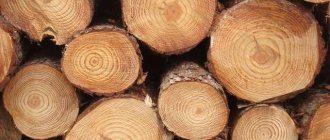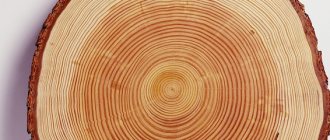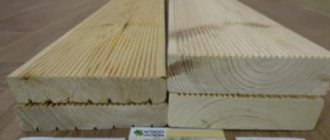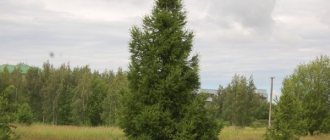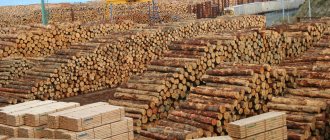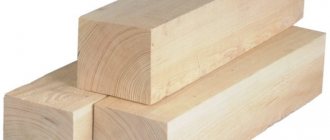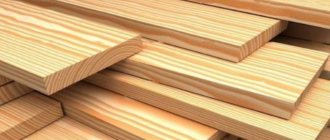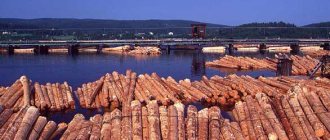One of the universal wood materials is larch, which has long been used in rural and urban construction. The tree grows in Russia, mainly in Siberia and the Far East. A total of 10 varieties of larch were discovered, the most widespread of which are the Siberian and Daurian varieties (99%).
Characteristics and properties of wood
- Density (specific gravity) – 400-450 kg/m3. The value is typical for conditionally dry wood, which has a uniform, undeformed structure.
- Volumetric weight – up to 850 kg/m3 (in a watered, freshly cut state). Individual wood cuts can have a density of more than 1000 kg/m3 and sink in water.
- Compressive strength (bending) – 48 (93) N/mm2. The parameters characterize the maximum load that can be maintained for a relatively long time.
- Tensile strength – 105 N/mm2. Represents the value of external force, which leads to rapid (within a few seconds) destruction of the material.
- Thermal conductivity – 0.13 W/(m K). With the exception of balsa wood, which has an abnormally low thermal conductivity, only spruce has similar thermal insulating properties. This makes it possible to widely use larch to create rooms that are maximally protected from heating and cooling.
- Elastic modulus – 13.8 hPa. Larch is distinguished by one of the highest values of the parameter characterizing the ability to elastically resist when external force is applied. The modulus of elasticity of larch wood is much higher than for a number of coniferous trees and even oak.
- The end and radial hardness of larch is 38.0 and 24.9 MPa, respectively (slightly less than for oak and ash). Due to its high hardness values, larch can be used in the construction of wear-resistant structures with low mass.
- Natural humidity is up to 25%, provided that it is stored in a dry place, protected from precipitation.
- Color ranges from reddish brown to darker shades.
- The texture of larch is determined by a longitudinal section and differs in the observed width of the growth rings. The colors of young and old wood, as well as the heartwood and sapwood, differ from each other. The knot content of the material is low, which improves the appearance and increases strength.
- The ignition and spontaneous combustion temperatures of larch are about 270 and 420 ºС - almost standard values for a number of wood materials.
- Hygroscopicity – low. This property makes it possible to make doors and window frames from wood that have a minimal swelling coefficient.
- Ash content – less than 0.5%. The composition of the ash mainly includes carbonates of alkali and alkaline earth metals, as well as impurities of their halides.
- Specific heat of combustion – 15.5 MJ/kg. Along with low density, this value means less heat generation with the same volumetric load of firewood. Larch is not recommended for making fires, as it is a source of numerous flying sparks.
- The chemical composition of the organic part of wood is represented by cellulose, hemicellulose and lignin. Larch can contain polysaccharides (arabogalactan) in a wide range (from 5 to 25%). The amount of resin is low, which allows the wood to be used in a number of food products.
- Resistance to rotting is high. Weak hygroscopicity, high mechanical properties and natural chemical inertness of larch make it a suitable material for structures buried in the ground, as well as underwater structures (piles, bridge supports).
Standardization of operational parameters is carried out according to GOST 26002-83, which regulates the properties and dimensions of lumber.
There are 5 types of wood in total. The first grade has the least defects, while the fifth grade allows the maximum natural and manufacturing defects.
Interior decoration – health, beauty and reliability
For interior decoration of apartments and private houses, larch lumber is the best option in terms of price-quality ratio, not to mention the beauty and richness of color and texture. Let's look at the most popular larch materials among developers:
- Larch floorboards are a reliable and durable material, but we must take into account that this tree loves moisture and with a sharp change in humidity, which is often observed in heated rooms, this material is prone to cracking. Therefore, if you really like the color and texture of the flooring in the house, then you only need to purchase a dry board. It’s easy to check, look at the cut and knock on the board; if the sound is clear, it’s dry. The board must have a storage life in a stack of at least two years after cutting. Such material costs more than fresh lumber;
- Larch parquet is worth choosing if the room's humidity requirements are taken into account, not lower than forty percent in winter. If the room is dry, then cracking is inevitable. Therefore, even a 10-year warranty from the manufacturer does not provide confidence that you will not have to scrape the floor in just a year. Of course, the material is budget and relatively inexpensive, but such parquet should not be laid in an apartment or a dry private house, even if it captivates with its beauty and grace;
- Doors made of larch are strong and reliable long-lasting protection. The strength of larch wood is comparable to oak. Hardness – 109 units. (according to the Brinell scale). Compression and tension indicators are almost twice as high as pine. Impact and deformation strength is forty percent higher. Therefore, although such a door is more expensive than a pine one, it is also more reliable than even cedar or fir. Also, such doors are an ideal solution for baths and saunas, their resistance to humidity is maximum;
- Windows made of larch are not inferior in strength to oak material, but cost half as much. The reason is simpler processing and the ability to cut complex parts without the use of special cutting tools. Resistance to moisture gives a guarantee for the use of such windows - 25 years. But it is important to treat it after installing the frame with a special primer for deep penetration wood;
- Larch flooring can be either parquet or regular edged boards, which are not afraid of fungus, mold and moisture. At an affordable price, high reliability and strength, resistance to deformation. When humidity increases, the material swells, and when humidity decreases, it contracts. This feature must be taken into account when installing the floor. We also remind you once again that the humidity in the room should not be below forty.
As you can see, materials made from larch are not much more expensive than their analogues from pine and cedar, but they differ in the main characteristic - high resistance to humidity. That is why larch is indispensable for exterior decoration; it has proven itself excellent in cladding balconies and loggias, baths and saunas. The beauty of the texture, warm shades of honey - there is scope for design options for any room.
Which is better - larch, pine or cedar
The differences between materials are in cost, as well as performance and environmental qualities. Pine is the cheapest type of wood and is easy to process, but has lower strength and thermal conductivity. Cedar is the most expensive lumber and is more suitable for mechanical processing than larch.
Siberian and Dahurian larches have average price and strength qualities. They are quite difficult to process, which is compensated by their greater cheapness. If you want to get the practical qualities of cedar (except for visual ones) and save on the cost of the material, larch is the best choice.
What is the difference between houses built from Siberian larch and cedar:
Larch
Characteristics of the tree.
Tree of the first size, 35-40 m high. In most cases, the crown shape is cylindrical.
The length of the crown is approximately 40% of the trunk height, and the fluctuations in the values of this characteristic are very large, 10-90%. The crown width in mature plantings is most often 3.5-5 m. It blooms in May. Needles on short shoots. At the end of September, the needles turn yellow and intensive shedding begins. Cones of various shapes. The width of the cones is somewhat shorter than their length. The average length of the cones is 29 mm, the minimum length is 15 mm. The maximum number of cone scales is 31, the minimum is 16. Weak pubescence of the scales is a characteristic feature of Chekanovsky larch. The maximum average number of needles in a bunch is 30. The average length of needles is 28 mm. The color of young shoots is dark. Reproductive organs are often damaged by late spring frosts. Fruiting can vary in different areas from 20 to 120 kg/ha. The emergence of seeds is very difficult, very difficult and stretched due to poor opening of the cones. In the fall (in the harvest year) 10% falls, and by the spring of the year following the harvest - 50% of the seeds. The maximum weight of 1000 seeds is 5.6 kg, the minimum is 3.3 kg. Wood.
The breed is sound. The kernel is colored brown. The sapwood is narrow, slightly yellowish with a clearly defined border between the core. The annual layers are clearly distinguishable.
Density at 15% humidity is 0.56-0.61 g/cm3, at 12% humidity - 0.41-0.59 g/cm3.
Drying.
Dries quickly, but unevenly in the radial and tangential directions.
Strength.
The wood is strong and heavy.
Persistence.
Wood does not rot.
Technological properties.
Processing requires special cutting tools.
Application.
It is used in the form of logs, balance beams, sleepers, power poles, as well as in underwater structures.
Larix
sukaczewii Djil . Dyl .
— Sukachev larch Family
Pinaceae Lindl .
Spreading.
It grows to the west of the Ob and Irtysh rivers, i.e. from the western border of Siberian larch to the eastern shore of Lake Onega in the European part of the USSR.
Characteristics of the tree.
A tree of the first size, height reaches 35-40 m, diameter 1.5 m. Close to Siberian larch, but has a number of distinctive features. The trunk is usually thickened towards the base. The shoots are light yellow and shiny. The branches are raised upward. The needles sit on short shoots of 20-60 pieces. in a bunch, 3-5 cm long. Cones are broadly ovoid, oval or spherical, 3-4 cm long, with woody, dark brown scales, covered with red fluff. The edges of the scales bend inward. Covering scales are not visible. The seeds are larger than those of Siberian larch, dark brown with dark specks and veins.
It grows in a mixture with other conifers: spruce, fir and pine. The main method of propagation is seed; vegetative is also common. Lives up to 350 years or more.
The breed is very valuable in forestry and landscaping.
Wood.
The breed is sound. The kernel is reddish-brown in color, the sapwood is slightly pinkish, narrow. The annual layers are clearly visible in all sections. On a radial cut, these are parallel narrow dark stripes of latewood alternating with lighter stripes of earlywood. On a tangential section, the annual layers diverge at an angle and form parabolas, the apices of which are directed along the trunk. On the end section, the annual s( / form concentric circles or parts thereof. The transition from early wood to late wood is especially clearly visible at the boundary of the annual ring. The medullary rays consist of radially elongated parenchyma cells. Resin ducts, vertical * and horizontal, form a single capillary system. Density at 15% humidity is 0.84 g/cm3, at 12% humidity -0.816 g/cm3.
Drying. The shrinkage of wood is significant and is uneven in the radial and tangential directions.
Strength. Wood from trees grown in the Urals has high technical qualities. At 12% humidity, the compressive strength along the fibers is 475 • 105 Pa, with static bending - 1065 • 105 Pa.
Persistence. Very resistant to rotting.
Technological properties. The wood is strong and resinous, which makes it difficult to process, and also heavy, which prevents it from being fused. Wood cracks during air and chamber drying, even under mild process conditions.
Application. Used in the construction of hydraulic structures.
How to distinguish larch from pine
Larch is a coniferous tree, but it has properties and appearance that are unusual for its species. Unknowingly, it is quite possible to buy pine lumber instead of hardwood.
To distinguish ready-made hardwood boards from pine boards, you should use the following criteria:
- pine boards or timber have a more pronounced light shade, acquiring a yellowish color over time. Larch is much darker, and after several years its color only becomes even more saturated;
- a nail can be driven into larch wood at the very edge of the board, while the pine material will crumble;
- leaving a dent in the wood after hitting it with a hammer is much easier on pine. Only minor damage will be observed on the larch.
This is what a larch tree looks like in the photo
Characteristics of larch tree
Larch is a coniferous tree that lives for about 600 years and reaches a height of 45-50 meters.
The diameter of the trunk at the butt of a larch can reach up to 2.5 m. The crown is ovoid-cone-shaped, narrow at a young age, wide in old trees, with a blunter apex, which, unlike European larch, does not bend. In old trees, the branches extend from the trunk almost at right angles, bending like a candelabra.
Family Pinaceae Lindl.
Varieties:
- Larix sibirica Ledeb. — Siberian larch;
- LarixdahuricaTurcz. exTrautv - Dahurian larch;
- Larix decidua Mill. — European larch, deciduous;
- Larix maritima Sukacz - Coastal larch;
- Larix olgensis A. Henry - Olgin larch;
- Larix Czekanowskii Sz - Czekanowski Larch;
- Larix SukaczewiiDjil. Dyl. — Sukachev’s larch.
Larch in nature
Siberian larch (Larix sibirica) is from the pine family. Its needles are soft and fall off every autumn like leaves - hence the name of the tree. Larch grows throughout Russia, but the most valuable species is found in Siberia. The tree has tall, large, even trunks with low knots. During the growth period, which lasts 100 years, it reaches 50 meters in height.
Larch branches
There is no reliable information regarding the maximum age to which this forest giant can live. During the construction of the Great Siberian Route, a larch tree 425 years old was found. However, there is information that in the Bratsk area there are still living trees that are more than 10 centuries old! For comparison: pine lives about 400 years.
Types and their features
There are several varieties of wood that are used in construction, product manufacturing and decorative purposes.
These include:
- Siberian - is the second most common type of larch, accounting for about 13% of trees;
- Daurian is the most common in Russia and makes up approximately 86% of all reserves.
- European (common) - grows in Western European regions. Most common in Sweden and Scotland. In Russia it is grown artificially and has decorative value;
- Japanese - cultivated in Europe and Russia since the end of the 9th century. Due to its high resistance to pests and attractive appearance, it is popular as an ornamental plant;
- weeping - has a small height (from 1 to 8 m), so it is often planted in summer cottages and in ornamental gardens. The small size of the crown does not create a shadow that prevents the growth of other trees;
- stained larch is a natural variety of larch that has been under water for a long time. It has abnormal strength and is extremely difficult to process. Artificial imitations only reproduce the darker color of the wood by covering it with a stain solution;
- brushed – is artificially aged wood. The essence of the treatment is to rub the surface and remove the softest wood fibers. The process resembles the natural aging of wood, but proceeds much faster.
Photos of some types of larch
Siberian larch
Siberian larch cones
European larch
European larch cones
Japanese larch and its cones
Daurian larch
Daurian larch cones
Larch compared to softwoods
Most conifers are softwood. This is pine, cedar, spruce, fir . After processing, lumber is obtained from the wood of these species - boards, timber, rounded logs, which are used for the construction of structures and finishing.
The cheapest material is pine, which is distributed over a large area of the European part of Russia and Siberia. European larch is looser and in terms of performance indicators is inferior to Siberian larch. The second most frequently used place is occupied by spruce.
Both of these types of wood have:
- low thermal conductivity coefficient;
- resistance to putrefactive processes;
- pleasant aroma;
- natural protection against damage by rodents and insects due to high resin content;
- high degree of frost resistance and resistance to changes in climatic characteristics;
- beautiful texture.
Larch has these same qualities, even to a greater extent, but as a building material with greater density, it has increased strength. Almost all indicators of the mechanical reactivity of larch are higher than those of pine, which in turn is superior to spruce and cedar.
Larch wood processing
Like any other type of wood, larch needs pre-treatment. It is usually subjected to the technologies described below.
Mechanical restoration
When preparing lumber, a number of difficulties arise related to the “greasing” of the cutting tool and the destruction of wood due to internal stresses that arise. This leads to an increased role of manual labor in preparing wood for the needs of private households.
Drying
Removing moisture requires observing not only moderate temperature conditions, but also special cutting of boards. When processing larch, combined drying processes are common, at the initial stage of which moisture is removed in convection chambers. Heating and heat treatment are carried out at the final stage of drying.
Chemical treatment
The material is initially resistant to microorganisms and requires minimal treatment with chemicals. The most commonly used are flame retardants, as well as oil and varnish impregnations. In conditions of high humidity, the surface is sometimes coated with antiseptic solutions.
Comparison of characteristics of larch and hardwood
- Hardwood species include such popular types of wood as oak, apple tree, beech, ash, hornbeam, and maple.
- Despite all the advantages of the wood of these species, the use of most of them is limited by the shape and size of the trunks, as well as the structure of the fibers.
- Larch is quickly and easily cleared of branches; its trunks have a slight taper, which is important when processing it.
- Oak, which has become the personification of a fortress, is the most popular material of this series for construction work and furniture making.
When comparing the quality characteristics of larch and oak wood, you should pay attention to the following indicators:
- The longevity rate of both breeds is almost the same.
- Both larch and oak are distinguished by their aesthetically attractive wood appearance, which is highly valued by furniture makers and interior designers. But in terms of the number of shades, larch is significantly superior to oak.
- Hardness on the Brinell scale for oak is 3.7; larch has 3.2. While inferior to oak in hardness, larch surpasses it in strength, only gaining strength over time.
- The cost of oak wood is significantly higher than that of the common larch.
- A significant disadvantage of oak is its hygroscopicity. Absorbing moisture, it begins to warp, and the product changes its original shape. In addition, oak wood is susceptible to rotting, which significantly reduces its service life.
Larch will not lose either its strength or charm over the years, filling the house with warmth and comfort.
Building material assessment
- Price – 3. Products made from pine can be many times more expensive than similar ones made from other types of wood.
- Practicality – 5. There are buildings and individual elements (piles, supports) that function for several centuries. The foundations of many wooden houses in Venice are made from larch over 500 years ago.
- Appearance – 5. Like most noble trees, larch is used without external coloring. The beautiful wood texture gives the product a special flavor.
- Ease of manufacture - 3. You can mechanically prepare the surface for coating with varnish or oil yourself, while it is better to entrust more delicate work to a professional carpenter.
- Labor intensity during use – 4. The low density of dried wood simplifies the installation and movement of deciduous structures, and its high hardness and strength make it difficult to fine-tune the component parts on site.
- Environmental friendliness - 5. The material is used to make the interior decoration of baths and saunas, and old larch barrels are used for aging wines.
Larch wood is one of the optimal materials for the construction of baths, saunas and exterior decoration of the house. The significant cost of buildings pays off with long-term use of larch products, which can be used by several generations of the family.
A few more words about larch:
What is made from larch for the household?
A number of luxury homes, known for their environmental properties, use hardwood tiles . Resistance to moisture makes this roofing covering quite durable and stable for decades. The wood structure allows the room to “breathe” and reduces the likelihood of rot.
Arbors made of larch retain their aesthetic appearance longer and do not acquire a blue color. The better fire resistance of larch helps protect the structure during short-term exposure to fire. The complexity of wood processing leads to a significant increase in the cost of complex carved elements.
When making a fence, larch wood allows you to preserve its integrity and strength properties for a long time. Supports buried in the ground are less susceptible to rotting, which is minimized after treatment with resin protective compounds. A larch fence is rarely painted, emphasizing the naturally beautiful texture with stain or oil.
Deciduous false beams bring the aroma of wood into the room and have a sanitary effect. Increased fire resistance allows you to mount separate elements of wiring and lighting systems to them.
Larch facades are a good alternative to plastering and give the building a special flavor. The wood base is usually treated with fire retardants and varnished to protect it from the abrasive effects of dust in strong winds.
You can watch a video on how to choose the right finishing material from larch below:
